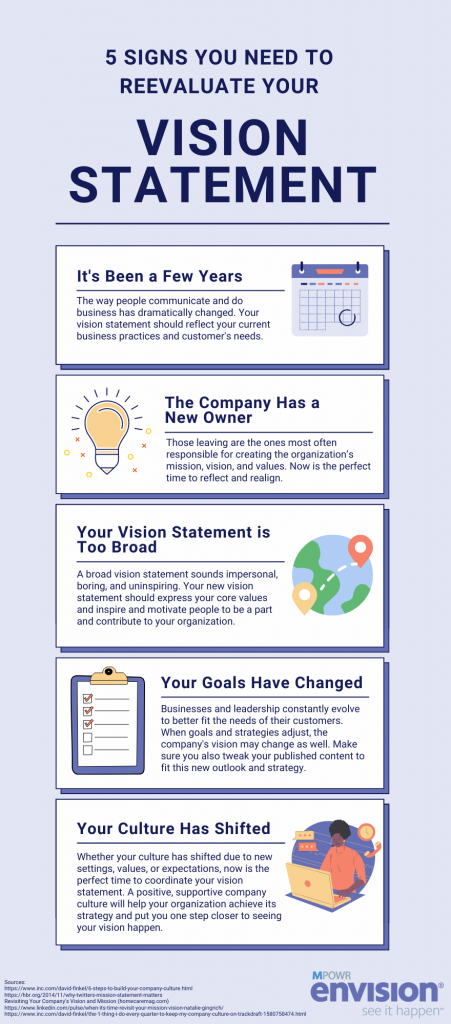
Connecting with Stakeholders: Defining Your Mission, Purpose Statement, Vision, and Values
October 13, 2021
Staying Engaged with Your Workplace Culture
November 19, 20215 Signs You Need a New Vision Statement [with Infographic]

Does your organization needs a new vision statement?
Read our five signs (or jump to the infographic!) to discover if yours is outdated and needs refreshing.
1. It’s Been a Few Years
Since the definition of a vision statement is what a company desires to achieve in five to ten years, we really hope you haven’t let a decade (or two) slip by without bringing this discussion to the table.
We don’t need to tell you that the world, and the way people communicate and do business, has dramatically changed.
Kroger Co. provides the perfect example of how reevaluating your vision statement and business model to meet customers’ needs can lead to increased revenue. In 2015 Kroger rolled out their ClickList feature that allowed busy customers to shop online and pick up groceries at nearby stores. In 2020 they noticed an increase of consumers cooking at home and transitioned a store in Ohio to pick-up only, achieving $1 billion in cut costs and improved digital profitability. Their willingness to adapt to demands and revisit their vision not only paid off, but made their customers feel valued.
Therefore, refreshing your vision — and being willing to constantly adjust while still staying aligned to your purpose and mission statement — will be your key to strategy success.
2. The Company Has a New Owner
Change in company ownership is hard, especially when those leaving are the ones most often responsible for creating the organization’s current mission, vision, and values.
Take if from Twitter, whose founders all left before the company turned eight. Users began noticing the lack of vision and values, and as a result, Twitter decided it needed to reevaluate. The strategy refresh worked immediately; after it was announced in 2014, the company stock price rose 7% by the end of the day.
What we can learn from this scenario is a company’s vision statement must align with its core values and objectives. Anything else will result in customer confusion and unsuccessful strategy execution.
3. Your Vision Statement is Too Generic
Another problem that many organizations face is a lack a solid original vision statement. Wallace Weeks, founder of Weeks Group strategy consulting firm, argues, “The essence of many vision statements I’ve seen is very broad and reflects an altruistic desire, such as ‘our company wants to help people.’”
The issue with too generic of a statement is that it sounds impersonal, bland, and uninspiring. “The challenge today,” Weeks says, “is to identify those segments [in which the organization rises above competitors] and narrow the company’s vision to help them.”
In short, knowing and positioning your company’s assets will help you create a much stronger, more applicable vision statement.
Whether you choose to carve out ample time for visioning, use a template, or schedule a consultation with a strategy expert, it’s important to craft a new, specific vision that inspires people and motivates them to want to be part of and contribute to your team.
4. Your Goals Have Changed
Smart businesses and their leadership constantly evolve to better fit the needs of their consumers. Natalie Gingrich, CEO of The Ops Authority, states that when goals and strategies adjust, the company’s vision may change as well.
By reflecting on newly established SMART goals and analyzing priorities, your organization will be on its way to creating an updated vision statement that reflects your current aspirations and strategy.
Additionally, if your goals have shifted, you will also need to comb through your published content. Gingrich advises organizations to “take this as an opportunity to clean up your blog posts and videos, archiving or tweaking anything that no longer fits with your business.”
5. Your Company Culture Has Shifted
What does a vision statement have to do with company culture? As Kathryn Minshew of The Muse declares, “A company is only as good as its people,” and your vision statement should unite your teams and motivate action.
So whether your culture has shifted due to new settings, values, or expectations, now is the perfect time to coordinate your vision statement.
And since “company culture is the hidden hand that shapes [a] team’s behavior,” as business coach David Finkel says, it’s important to consistently revisit your vision statement to determine if it’s moving employees in the right direction.
Finkel also encourages quarterly check-ins of your company’s culture to see if it is aligning with your vision. These scheduled analyses also signal to staff that culture isn’t just an aspirational talking point, but instead a realistic representation of company values.
As a result, a positive, supportive company culture will help your organization achieve its strategy and put you one step closer to seeing your vision happen.
![5 Signs You Need a New Vision Statement [with Infographic]](/wp-content/uploads/2022/10/getlogo.png)


